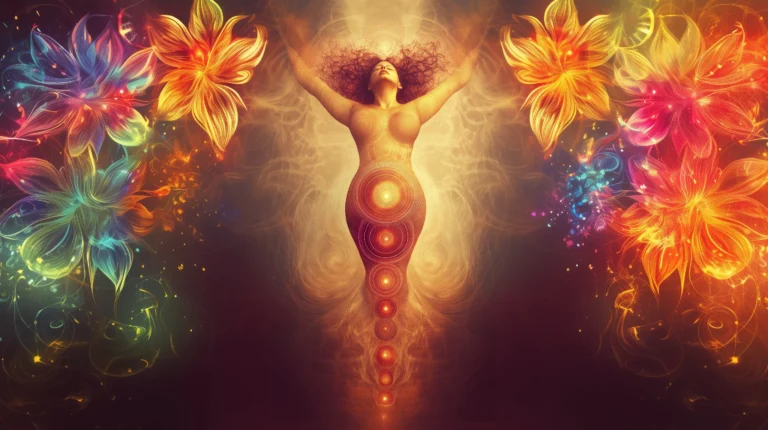From Shadows to Light
Welcome to “From Shadows to Light: Unraveling the Human Mind through Philosophy, Psychology, and Esoteric Wisdom.” As you open the pages of this book, you’re beginning a transformative journey that seeks to shed light on the intricacies of the human condition, guided by the penetrating insights of philosophy, the nuanced understanding of psychology, and the profound wisdom of esoteric teachings.
The human mind is a complex entity. From its labyrinthine depths emerge a myriad of thoughts, feelings, and emotions that shape our perception of ourselves and the world around us. Some of these inner experiences propel us towards growth and fulfillment, while others pull us into the shadows of fear, self-doubt, and despair. The latter, if left unchecked, can make life seem a burdensome ordeal, devoid of joy, purpose, or meaning. But does it always have to be this way? Can we navigate and, in fact, transform these darker shades of the human experience? The purpose of this book is to explore these crucial questions and, hopefully, discover empowering answers.
In the first part of the book, we delve into the human condition’s diverse aspects, from the everyday struggles of negative thinking, low self-esteem, and jealousy to the more severe psychological conditions like schizophrenia. We discuss the implications of constantly seeking others’ approval and the burden of self-imposed limitations. It’s an exploration that takes us into the darker corners of the human psyche but one that is essential to appreciate the struggles that so many of us face in our lives.
As we move to the second part, our journey takes a turn. The focus shifts from understanding our struggles to discovering ways to transform them. Here, we talk about resilience, the remarkable ability that allows us to bounce back from adversity and keep going. We explore the concept of self-actualization, an idea popularized by psychologist Abraham Maslow that speaks to the profound desire within each of us to realize our full potential. Additionally, we delve into how solitude can be a powerful tool for personal growth and self-discovery.
The final part of the book merges the philosophical, psychological, and esoteric viewpoints to form a holistic understanding. It addresses the fundamental question, “Why is life worth living?” and aims to rekindle the spark that makes life not just a mere existence, but an enriching, meaningful journey.
While the chapters of this book may seem disparate, they are, in fact, interconnected pieces of a larger puzzle. Each chapter builds upon the others, weaving a tapestry of insight and understanding that we hope will illuminate your path, whether you’re navigating the storms of personal struggle or embarking on the quest for self-realization.
This book is not just a theoretical exploration but a practical guide. We have made an effort to provide actionable strategies and thought-provoking insights that can be applied in real-world scenarios. We invite you to approach this book with an open mind and a receptive heart. It’s our sincere hope that as you turn the pages, you’ll find wisdom and guidance that resonates with you, offering solace, insight, and inspiration.
Thank you for embarking on this journey with us. We hope that by the end, you’ll have gained a deeper understanding of yourself and the human experience, allowing you to step out of the shadows and into the light of self-awareness, resilience, and self-fulfillment.
Part I: Understanding the Human Condition
Chapter 1:
The Experience of Life

Our Perception of Life
Life, with its myriad moments, experiences, and possibilities, is as complex as it is simple, as predictable as it is uncertain, and as joyous as it is painful. Each of us sees life through a unique lens, a prism constructed from our individual experiences, cultural upbringing, personal beliefs, and psychological tendencies. This lens, our perception of life, shapes our interpretation of the world around us and defines our reality.
For instance, imagine looking at a glass containing equal amounts of water and air. While one person might see the glass as half-full, focusing on its potential and positivity, another might view it as half-empty, emphasizing what is lacking or missing. The glass remains the same, but the perceptions differ drastically. It’s our perception that colors our world, adds meaning to our experiences, and ultimately creates the narrative of our lives.
However, our perception of life is not fixed. It’s fluid, dynamic, and susceptible to change based on our experiences, attitudes, and cognitive growth. As we navigate through the trials and triumphs of life, our perception continually evolves, informing how we understand ourselves, relate to others, and interact with the world.
The Human Experience and Its Diversity
Just as our fingerprints are unique, so too are our experiences of life. This diversity stems from several factors. Our physical environments, cultural backgrounds, personal history, individual personalities, and myriad other variables come together to create a complex tapestry of unique human experiences. No two life journeys are exactly alike, and it’s this diversity that brings richness and depth to our collective human existence.
Consider the intricate interplay between the individual and the environment. A person growing up in the heart of a bustling city might develop a love for rapid change, diversity, and constant stimulation, while someone raised in the peaceful countryside might come to value tranquility, nature, and the steady rhythm of life tied to the land. Their experiences are different, but each is equally valid and forms a vital part of the overall human experience.
In addition, our psychological traits significantly contribute to our unique experience of life. Introverted individuals might derive satisfaction from solitude and in-depth, focused activities. In contrast, extroverted people might thrive in social situations, finding joy in interactions and shared experiences. Again, these divergent experiences, molded by our individual psychological traits, add to the broad spectrum of human life.
It’s important to remember that all these variations don’t imply a hierarchy of experiences, with some being superior and others inferior. Instead, they underscore the beauty and richness of the human condition in all its diverse forms. Understanding this diversity can inspire empathy, foster open-mindedness, and encourage us to appreciate life in all its fascinating complexity.
As we delve deeper into the chapters that follow, we will explore how our individual perceptions and diverse experiences can sometimes lead us into psychological pitfalls like negative thinking, low self-esteem, and emotional turmoil. But fear not, for we will also uncover how these challenges can serve as catalysts for profound personal growth, resilience, and self-actualization.
This journey begins with understanding our unique experience of life, for it’s this understanding that serves as the foundation upon which we build our path to self-discovery and transformation. Life, with all its ups and downs, joys and sorrows, challenges and victories, is a complex, beautiful mosaic of experiences. And it’s this mosaic that we call the human experience.
Chapter 2:
Why Should I Stay Alive?

Understanding the Value of Existence
“Why should I stay alive?” This profound and sometimes haunting question often arises during life’s darker moments, when hope seems to fade, and joy seems distant. The query is a testament to the human capacity for introspection and self-awareness, a trait that sets us apart from other species. Yet, it’s a question that can deeply challenge us, plunging us into existential crises and existential despair.
It’s essential to understand that the value of existence isn’t determined by transient states or conditions, be they joyous or painful, triumphant or devastating. Rather, the true value lies in the simple but profound fact of being alive, of participating in the grand tapestry of existence, of being a conscious entity capable of experiencing, learning, and evolving.
To understand the value of existence, consider the universe’s immensity, with countless galaxies, stars, and celestial bodies. Yet, in all that vastness, as far as we currently know, Earth is the only place where life exists – a tiny island of life amidst a cosmic ocean. Your existence contributes to this rare and precious phenomenon, making you an integral part of the cosmic symphony.
The philosopher Friedrich Nietzsche once said, “He who has a why to live can bear almost any how.” Finding that ‘why’, understanding the value of our existence, can provide a sense of purpose, a guiding beacon that helps navigate life’s storms. While the specific ‘why’ might vary from person to person, the broader truth remains – our existence, in itself, is valuable.
Life’s Intrinsic Worth
The belief in life’s intrinsic worth forms the bedrock of many philosophical and ethical systems. The idea is that life, simply by virtue of being life, possesses inherent value. This isn’t contingent on any external factors, such as achievements, social status, wealth, or even the approval of others. Instead, it’s an inherent worth that resides in the core of our being, a worth that is unshakeable and enduring.
But how does understanding life’s intrinsic worth answer the question, “Why should I stay alive?” To answer this, we need to delve deeper into what it means to be a conscious, sentient being.
As human beings, we have the extraordinary ability to think, feel, perceive, imagine, create, love, and aspire. We can marvel at a sunrise, get lost in a piece of music, immerse ourselves in a book, be moved by acts of kindness, and experience a spectrum of emotions. We can learn, grow, and evolve. We can form deep, meaningful relationships with others, touch lives, and have our lives touched in return. We can dream and strive to make those dreams a reality. All these aspects represent the intrinsic worth of life, a worth that is intimately tied to our experience as conscious, sentient beings.
There’s a line from a poem by Mary Oliver that beautifully captures this sentiment: “Tell me, what is it you plan to do with your one wild and precious life?” Life, in all its wildness and preciousness, in all its pain and beauty, in all its challenges and triumphs, is a profound gift. Embracing this understanding can imbue us with a deep appreciation for the intrinsic worth of our existence and provide a compelling answer to the question, “Why should I stay alive?”
The journey from understanding the value of existence to realizing life’s intrinsic worth is a deeply personal and transformative one. It requires introspection, courage, and openness. It isn’t always easy, especially when we’re grappling with the shadows within our psyche. But as we’ll discover in the subsequent chapters, it’s a journey that can lead us from darkness to light, despair to hope, and fear to resilience.
Chapter 3:
The Psychological Traps

Negative Thinking: Its Roots and Effects
Negative thinking, a state where our mind tends to drift towards pessimistic outcomes and perspectives, is one of the most common psychological traps we fall into. Often, it can become such a habitual pattern that we may not even realize we’re caught in its grips.
The roots of negative thinking lie in a variety of factors. Some arise from our upbringing, where constant criticism or lack of positive reinforcement can condition us to view the world and ourselves in a negative light. Some can be attributed to past experiences of failure or rejection, leading us to anticipate similar outcomes in the future. For others, negative thinking could be a symptom of a deeper psychological condition like depression or anxiety.
The effects of negative thinking are far-reaching. It can lead to reduced confidence, hinder our performance in various life areas, and can often result in a self-fulfilling prophecy, where our negative expectations lead to negative outcomes. Furthermore, persistent negative thinking can also have severe implications for our physical health, contributing to stress, weakened immunity, and even increased risk of cardiovascular disease.
Low Self-esteem: A Barrier to Personal Growth
Self-esteem is the value we attribute to ourselves. When this value is low, we perceive ourselves as unworthy, incompetent, or unlovable. These self-deprecating views often act as significant barriers to personal growth.
Low self-esteem can stem from several sources, such as traumatic experiences, negative early-life environments, unhealthy relationships, or consistent failure. People with low self-esteem often experience a continuous cycle of self-doubt and self-criticism, which hinders them from recognizing their true potential and worth. This lack of self-worth may cause avoidance of opportunities for fear of failure, leading to a life lived beneath one’s potential.
Self-blame and Blaming Others: The Cycle of Guilt and Resentment
Self-blame and blaming others are two sides of the same coin, both rooted in an inability to process experiences healthily. Self-blame is an internalization of faults and mistakes, a belief that we alone are the cause of our problems. This pattern of thinking can lead to guilt, shame, and an exacerbation of low self-esteem.
On the other hand, habitually blaming others is an externalization of responsibility, leading to resentment, anger, and deteriorating relationships. It prevents us from understanding our role in our problems, which hinders personal growth and self-improvement.
Both self-blame and blaming others are harmful, as they distort our perception of reality and disempower us. Understanding these patterns and breaking free from them is crucial for emotional and psychological well-being.
The Trap of Seeking Others’ Approval
The desire for social acceptance is inherent in us as social beings. However, when the need for others’ approval becomes a compulsive pursuit, it turns into a psychological trap that can severely limit our authenticity and independence.
People trapped in the cycle of seeking others’ approval often suppress their desires, opinions, and personality to conform to others’ expectations. This behavior can lead to a loss of personal identity, decreased self-confidence, and increased susceptibility to manipulation and coercion.
The need for approval often originates from a fear of rejection or a belief that others’ opinions validate our worth. Breaking free from this trap involves building self-esteem, fostering self-acceptance, and developing the courage to express oneself authentically.
In summary, these psychological traps – negative thinking, low self-esteem, self-blame and blaming others, and the need for others’ approval – can significantly impact our mental health, happiness, and potential for growth. Recognizing these traps is the first step towards liberation. In the coming chapters, we will delve into how we can navigate and overcome these psychological obstacles, transforming them into stepping stones for growth, resilience, and self-actualization.
Chapter 4:
Emotional Turmoil

Fear, Anxiety, Depression: Understanding these States
Fear, anxiety, and depression are emotional states that, when experienced intensely or persistently, can lead to significant distress and disruption in our lives.
Fear is an immediate emotional response to a perceived threat. It serves an essential function, priming our body to either face the danger or flee from it. However, when fear becomes chronic or disproportionate to the situation, it can become debilitating, limiting our ability to function effectively.
Anxiety, while related to fear, is less about an immediate threat and more about anticipated future uncertainties. It often manifests as excessive worry, restlessness, and tension. Persistent anxiety can hinder our decision-making abilities, disrupt sleep, and lead to physical symptoms like headaches and stomach issues.
Depression is a mood disorder characterized by persistent feelings of sadness, loss of interest in previously enjoyed activities, and a lack of energy. It can impact our ability to work, maintain relationships, and even carry out basic daily activities. In its most severe form, depression can lead to suicidal thoughts and behaviors.
Understanding these states is crucial because it equips us with the knowledge to recognize and address these issues, either through self-help strategies or professional intervention.
Mood Swings: The Emotional Rollercoaster and Its Impact on Life
Mood swings refer to rapid and extreme changes in emotion, like moving from a state of euphoria to one of despair within a short time frame. While everyone experiences fluctuations in mood, intense and frequent mood swings can create an emotional rollercoaster that impacts all aspects of life – from relationships to productivity and overall well-being.
The causes of mood swings are varied, ranging from hormonal changes, stress, and lifestyle factors to psychological conditions like bipolar disorder or borderline personality disorder. Mood swings can cause unpredictability in behavior, leading to conflicts in relationships and inconsistency in personal and professional commitments. Managing mood swings often involves a combination of lifestyle adjustments, psychological therapies, and, in some cases, medication.
Jealousy and Envy: The Toxic Effects on Self and Relationships
Jealousy and envy, though sometimes used interchangeably, are distinct emotions. Jealousy typically involves three people and stems from the fear of losing something or someone we value to a perceived rival. Envy, on the other hand, is a two-person scenario where we desire what someone else has.
Both jealousy and envy can have toxic effects on our sense of self and our relationships. They can lead to feelings of inadequacy, resentment, and unhappiness. When intense or unmanaged, these emotions can lead to destructive behaviors, such as manipulation, sabotage, or even aggression.
Understanding these emotions, their triggers, and their impacts is a step towards managing them in a healthy way, thus reducing their toxicity. It’s important to remember that these emotions, like all emotions, are part of the human experience. It’s not the emotions themselves, but how we handle them, that determines their effect on our lives.
In summary, emotional turmoil, whether arising from states like fear, anxiety, depression, mood swings, or emotions like jealousy and envy, can create significant challenges in our lives. However, as we’ll explore in the coming chapters, we can learn strategies to manage and navigate these emotional states, fostering resilience and leading us towards emotional equilibrium and psychological growth.
Chapter 5:
No Spark in Life

Feeling Angry, Dissatisfaction: Identifying and Addressing the Root Causes
Many of us, at times, feel a pervasive sense of anger or dissatisfaction in our lives. These feelings might manifest as a general discontent with our circumstances, a sense of life lacking a spark, or a fiery resentment that keeps us in a constant state of agitation.
Anger, while often seen negatively, is a normal and even healthy emotion. It alerts us when something is wrong, when our boundaries have been violated, or when we encounter injustice. The problem arises when anger becomes chronic, unmanaged, or directed towards inappropriate targets, leading to personal distress and strained relationships.
Dissatisfaction, on the other hand, can arise from unmet expectations, thwarted goals, or a discrepancy between our current life situation and the ideal we hold in our minds. Chronic dissatisfaction can sap the joy out of life, keeping us in a perpetual state of wanting rather than appreciating what we have.
To address these feelings, we first need to identify their root causes. This involves introspection and, at times, confronting uncomfortable truths about ourselves or our circumstances. The causes might include unresolved past traumas, unmet needs, unhealthy relationships, or unfulfilled aspirations. By recognizing these root causes, we can devise strategies to address them, whether through communication, therapy, lifestyle changes, or personal growth initiatives.
From a philosophical perspective, the existentialists suggest that feelings of anger and dissatisfaction can arise when we aren’t living authentically, or in alignment with our true selves and values. In existential therapy, individuals are encouraged to confront these feelings, accept the responsibility for their lives, and enact changes that align their actions with their values and passions.
Psychologically, techniques such as cognitive-behavioral therapy (CBT) can be useful to challenge and alter the cognitive distortions that often underlie chronic anger and dissatisfaction. Mindfulness-based therapies can also assist in improving emotional regulation and cultivating acceptance.
From an esoteric viewpoint, emotions like anger and dissatisfaction could be seen as disruptions in our spiritual energy or misalignments with our higher purpose. Practices like meditation, energy healing, or chakra balancing might be used to address these disruptions, bringing about emotional harmony and aligning with our true spiritual path.
Self-imposed Limitations: The Invisible Chains
One of the major barriers that can extinguish the spark in life is the set of self-imposed limitations we often unconsciously create. These limitations can be thought of as invisible chains that bind us, preventing us from reaching our full potential and experiencing life’s richness.
These self-imposed limitations often come in the form of negative self-beliefs, such as “I’m not good enough,” “I can’t do this,” or “I don’t deserve happiness.” They may also manifest as self-defeating behaviors, like procrastination or self-sabotage, which hinder our progress towards our goals.
These limitations are often rooted in past experiences, such as criticism from significant others, failures, or rejections. Over time, these experiences can morph into generalized beliefs about our capabilities and worth.
Breaking free from these self-imposed limitations involves challenging these negative self-beliefs and replacing them with more positive and realistic ones. It may also involve learning new skills, seeking support, and stepping out of our comfort zone to pursue our true aspirations.
Our self-imposed limitations often operate like shadows in our psyche, hiding in the unconscious and subtly influencing our beliefs, decisions, and actions.
From a philosophical standpoint, many thinkers, such as the Stoics, have encouraged self-reflection to identify and challenge these limiting beliefs. Stoic philosophy teaches that we are more in control of our minds and reactions than we think, and that our limitations are often self-imposed.
From a psychological perspective, therapies such as cognitive-behavioral therapy can help identify and challenge these self-limiting beliefs. Techniques from positive psychology, like strength identification and fostering a growth mindset, can also assist in breaking these invisible chains.
Esoterically, practices like meditation, dream work, or the use of rituals can be used to delve into the unconscious mind and unmask these self-imposed limitations. Once these limiting beliefs are brought to light, spiritual practices can be used to cleanse, heal, and transform these shadows, fostering a more holistic and empowered sense of self.
Lighting the Spark: A Path Forward
The path to lighting the spark in life is a journey of self-discovery, transformation, and alignment with our true selves.
Philosophically, we can draw inspiration from the existentialist idea of living authentically, the stoic pursuit of virtue and wisdom, or the Eastern philosophy of harmony and balance. We are encouraged to reflect deeply, challenge our current paradigms, and strive to live in alignment with our deepest values and truths.
Psychologically, we can utilize various therapeutic techniques to address our emotional turmoil, challenge our limiting beliefs, and cultivate resilience. We can build emotional intelligence, foster a growth mindset, and develop adaptive coping mechanisms.
From an esoteric perspective, this journey can be seen as a spiritual quest for self-actualization or enlightenment. This might involve meditative practices to cultivate inner peace, energy work to balance our spiritual energy, or the pursuit of mystical knowledge to understand our place in the cosmos.
The journey to light the spark in life involves merging these paths, intertwining self-awareness with personal growth and spiritual alignment. As we navigate this path, we begin to break free from the shackles of our limitations, fuel the spark of our potential, and set our lives ablaze with purpose, passion, and joy.
In this chapter, we’ve discussed the feelings of anger and dissatisfaction and the self-imposed limitations that can lead to a sense of life lacking a spark. Recognizing and addressing these issues is a significant step towards reigniting that spark. In the coming chapters, we’ll delve into strategies and principles that can help us reclaim our life’s vibrancy, leading us towards resilience, growth, and self-actualization.
Chapter 6:
Navigating Severe Mental Conditions

This chapter focuses on schizophrenia, which serves as an exemplar of these conditions due to its complexity and impact on individuals’ lives. Schizophrenia is by no means the only severe mental health condition, but it offers a detailed case study that can shed light on the broader category of severe mental health disorders. By choosing to spotlight schizophrenia, we aim to extend our discussion to encompass other severe mental health conditions. We hope that our exploration fosters greater empathy and awareness, empowering readers to better understand, support, and potentially navigate similar challenges, either in their lives or in the lives of those around them.
Schizophrenia
Schizophrenia is a chronic and severe mental disorder that affects how a person thinks, feels, and behaves. Characterized by distortions in thinking, perceptions, emotions, sense of self, and behavior, schizophrenia can be deeply disorienting and disruptive, affecting every facet of an individual’s life.
Understanding Schizophrenia
From a psychological perspective, schizophrenia is typically marked by symptoms such as hallucinations, delusions, disorganized speech or behavior, and impairments in daily functioning. It’s a complex disorder, the cause of which is thought to be a combination of genetic, environmental, and neurological factors.
Hallucinations are sensory experiences that occur without a stimulus. Auditory hallucinations, such as hearing voices, are most common in schizophrenia. Delusions are fixed false beliefs that are not aligned with cultural norms and remain in place despite evidence to the contrary.
Importantly, the experience of schizophrenia is not uniform and varies significantly from person to person. For some, it can be a single episode, while for others, it can be a lifelong journey with periods of relative normalcy punctuated by severe episodes.
Coping with Schizophrenia
Dealing with schizophrenia, whether you’re the one diagnosed or a loved one, is a journey that requires knowledge, support, compassion, and resilience. Here are several strategies that can help navigate this condition:
1. Medical Treatment: Antipsychotic medications are the first line of treatment for schizophrenia and can help manage symptoms such as hallucinations, delusions, and disorganized thinking. Regular consultation with a psychiatrist is crucial for medication management.
2. Psychotherapy: Cognitive-behavioral therapy (CBT) for psychosis can be particularly beneficial. It can help individuals recognize and challenge their delusions or hallucinations and learn coping strategies.
3. Education: Understanding the nature of the disorder can aid in managing it more effectively. This includes learning about its symptoms, causes, treatments, and prognosis.
4. Support Networks: Family, friends, and support groups can provide emotional assistance. They can also assist with practical matters such as ensuring medication is taken, attending appointments, and managing daily tasks.
5. Healthy Lifestyle: Regular physical activity, a balanced diet, adequate sleep, and avoidance of alcohol, caffeine, and illicit substances can help manage symptoms and improve overall well-being.
Trouble with Thinking and Lack of Motivation
Among the most challenging symptoms of schizophrenia are cognitive impairments and negative symptoms, including trouble with thinking and a lack of motivation.
Cognitive impairments in schizophrenia often involve problems with concentration, memory, attention, and executive functions, such as planning and decision-making. These difficulties can interfere with the ability to work, study, and carry out daily tasks. From a psychological perspective, cognitive remediation therapies have been developed to address these cognitive deficits, using exercises and activities that aim to improve cognitive functions and enable better daily functioning.
Apathy or lack of motivation, referred to as avolition in clinical terms, is one of the negative symptoms of schizophrenia. It is characterized by a decreased ability to initiate and persist in self-directed purposeful activities. This can manifest as neglect of personal hygiene, social withdrawal, and a lack of interest in everyday activities.
Therapeutically, addressing avolition often involves motivational interventions and behavioral activation strategies, including setting realistic and personalized goals, progressively increasing activity levels, and providing positive reinforcement for achieved tasks.
The Esoteric Perspective
From an esoteric perspective, some traditions might view the symptoms of schizophrenia not merely as pathological phenomena but also as potential avenues for spiritual development or transformation.Some esoteric traditions might view schizophrenia as a form of spiritual crisis or awakening. While such views should be navigated with extreme caution and respect for the distress caused by the condition, they offer an additional dimension of understanding and coping.
The cognitive disorganization and lack of motivation, seen from an esoteric lens, could be interpreted as a disruption in one’s energy or spiritual alignment. Some practices might suggest that rebalancing this energy could help in coping with these symptoms. Such practices could include meditation, energy healing, or the use of symbolic rituals.
In the realm of transpersonal psychology, which blends psychological concepts with spiritual traditions, there is the idea that such a crisis can potentially be transformative. They propose integrating traditional therapeutic approaches with mindfulness, self-awareness practices, and exploration of the spiritual dimensions of the experience.
However, these esoteric or transpersonal perspectives are not meant to replace conventional treatment methods. Instead, they may serve as a complementary approach for those who resonate with such views, always in consultation with healthcare professionals to ensure a safe and effective treatment plan.
In sum, navigating the cognitive and motivational challenges in schizophrenia is a complex task requiring a multifaceted approach. By combining psychological treatments with a broader understanding of the individual’s experience, it’s possible to cultivate resilience and improve quality of life. Remember, each person’s journey is unique, and what works best will depend on the individual’s specific symptoms, circumstances, and personal beliefs.
Part II: Journey to Self-Discovery and Transformation
Chapter 7:
Resilience: The Power to Recover

Defining Resilience
Resilience is an inherent human trait that embodies our capacity to bounce back from adversities, navigate through challenges, and continue to grow and evolve. It’s the psychological strength that allows us to rebound from hardship and move forward in the face of difficulty. Resilience is not about avoiding stress or hardship but about learning to thrive within it.
The Role of Resilience in Overcoming Challenges
Whether in the face of everyday stressors or significant life crises, resilience is the cornerstone of our ability to cope effectively. It helps us maintain balance in our lives during difficult or stressful periods, and it can also protect against the development of mental health conditions, such as depression and anxiety.
Resilience doesn’t mean we don’t experience difficulty or distress. On the contrary, the road to resilience often involves considerable emotional pain. However, individuals who embody resilience don’t see this discomfort as a permanent or an insurmountable hindrance. Instead, they recognize that pain is a part of life’s journey and feel equipped to face and work through these challenges.
Strategies to Build Resilience
Building resilience is an ongoing process that requires time and effort. Here are a few strategies:
1. Positive Relationships: Build strong, positive relationships with loved ones and friends who can offer support and acceptance. Being part of a community gives you a sense of belonging and self-worth, which can help you in times of stress.
2. Wellness: Take care of your body. Physical well-being has a significant impact on mental and emotional health. Regular exercise, a healthy diet, adequate sleep, and avoiding harmful substances can boost your resilience.
3. Mindful Practices: Mindfulness can help you stay focused on the present moment, which can help you prevent overwhelming feelings of worry. Practices such as meditation, deep-breathing, yoga, or tai chi can enhance your ability to stay calm under stress.
4. Positive Thinking: Optimism and a positive outlook can help you view adversities as opportunities for growth rather than threats. Embrace a growth mindset, seeing challenges as opportunities to learn and evolve.
5. Goal Setting: Set realistic goals and move towards them one step at a time. Having a sense of purpose and direction can strengthen your resilience.
6. Self-Discovery: Understand that crises are oftentimes transformative. Adversities are opportunities for self-discovery and personal growth.
7. Acceptance: Accept that change is a part of living and that not all things are within our control. Resilience involves adapting to change and moving forward.
From an esoteric perspective, resilience might be seen as an expression of our spiritual strength and alignment. It can be cultivated through spiritual practices that promote inner peace, self-awareness, and connection with a larger reality, whether that’s nature, the cosmos, or a sense of the divine.
In conclusion, resilience is a dynamic and multifaceted process, with roots in our psychological, physical, and potentially, spiritual dimensions. By fostering this inner strength, we equip ourselves with the tools to navigate life’s ups and downs effectively, emerging from each challenge stronger, wiser, and more adaptable. Resilience is the key to turning adversities into stepping stones towards growth and self-actualization.
Chapter 8:
The Path to Self-Actualization

Understanding Self-Actualization
Self-actualization is a term that was first introduced by the psychologist Abraham Maslow in the mid-20th century. He described it as the process of realizing and fulfilling our potential and becoming the best version of ourselves. It’s the ultimate stage of psychological development where we reach our full potential, moving beyond mere survival needs to express ourselves creatively and find a personal, meaningful purpose in life.
Self-actualization isn’t an end state but an ongoing process of growth and understanding, a journey of becoming who we truly are. It’s about authenticity, being true to oneself, and living in harmony with our deepest thoughts, values, and feelings.
Moving Past Fears and Insecurities
One of the significant barriers to self-actualization is our own fears and insecurities. These can limit our potential and keep us from pursuing our true passions and interests. They can keep us stuck in comfort zones, leading to a life that is less than what we are truly capable of living.
However, moving past these fears and insecurities is a crucial step in the journey towards self-actualization. This requires courage, self-awareness, and a willingness to face and work through our fears. It involves recognizing our insecurities, understanding their roots, and challenging the limiting beliefs that underlie them.
Strategies for Growth and Self-Fulfillment
Here are a few strategies for self-growth and fulfillment:
1. Self-Reflection: Regularly take time for introspection. Understand your values, passions, and goals. This can help guide your life decisions and keep you aligned with your true self.
2. Mindfulness: Stay present and live in the moment. Mindfulness helps you recognize your feelings, thoughts, and bodily sensations, fostering a deeper self-awareness.
3. Facing Fears: Identify your fears and confront them. It can be a difficult process but a rewarding one. Taking small steps to face your fears can lead to significant personal growth.
4. Continuous Learning: Keep an open mind and continue learning new things. This can broaden your horizons and contribute to your sense of self-actualization.
5. Healthy Relationships: Build and maintain meaningful relationships. Connecting with others can provide emotional support, different perspectives, and enrich your life experiences.
6. Physical Well-being: Take care of your physical health. Regular exercise, healthy nutrition, and good sleep can enhance your mood, energy levels, and overall well-being, creating a positive cycle for self-growth.
From an esoteric perspective, self-actualization might be viewed as a spiritual journey towards the realization of one’s divine nature or connection with the cosmos. Various spiritual practices, such as meditation, yoga, or sacred rituals, could be seen as paths towards self-actualization, fostering a sense of inner peace, unity, and expanded consciousness.
In conclusion, self-actualization is a lifelong journey, an ongoing process of learning, growth, and expansion. By committing to this journey, we embrace the opportunity to express our fullest potential, to live in alignment with our deepest truths, and to contribute to the world in meaningful and fulfilling ways.
Chapter 9:
Solitude: A Catalyst for Growth

The Power of Solitude
In our hyper-connected world, the idea of solitude can sometimes be misunderstood or even feared. It can evoke images of loneliness, isolation, or a sense of being unwanted. However, solitude is far from these misconceptions. Instead, it is a powerful state of being that can lead to deep personal growth and transformation.
Solitude is the state of being alone without feeling lonely. It’s a time for introspection, for quiet reflection, and for nurturing your relationship with yourself. It’s a space where you can be free from distractions and social expectations, where you can hear your thoughts, feel your emotions, and attune to your inner wisdom.
How Solitude Can Aid in Self-Discovery and Transformation
When embraced consciously and mindfully, solitude can be a catalyst for self-discovery and transformation. Here’s how:
1. Provides Space for Reflection: In solitude, we can quiet the external noise and tune in to our thoughts, feelings, and desires. It provides the space to reflect on our experiences, our choices, and our future directions. This process of self-reflection can lead to self-awareness, self-understanding, and eventually, self-acceptance.
2. Fosters Creativity: Solitude gives the freedom to explore ideas and possibilities without the influence or judgment of others. It’s a fertile ground for creativity, innovation, and problem-solving.
3. Facilitates Emotional Processing: Being alone with our thoughts and feelings allows us to confront and process our emotions honestly and fully. It can help us heal old wounds, release pent-up emotions, and find inner peace.
4. Encourages Self-Reliance: Solitude teaches us to rely on ourselves for our happiness and fulfillment, reducing dependency on others for emotional well-being. It fosters self-confidence, independence, and resilience.
5. Promotes Mindfulness and Presence: Solitude encourages mindfulness, a state of active, open attention to the present moment. This heightened state of awareness can enhance our experience of life, deepen our connection to ourselves, and promote inner peace and well-being.
From an esoteric perspective, solitude is often seen as a path towards spiritual awakening or enlightenment. Many spiritual traditions encourage practices like meditation, silent retreats, or periods of seclusion as ways to deepen one’s spiritual connection, realize inner truths, or experience states of higher consciousness.
In conclusion, solitude is not a state to be feared but to be embraced. It’s a profound journey inward, a gateway to self-discovery and transformation. By finding comfort and value in our own company, we can tap into our inherent wisdom, nurture our inner growth, and truly actualize our potential. This, in turn, enriches our relationships with others, as we engage from a place of self-awareness, authenticity, and inner peace.
Chapter 10:
Why is Life Worth Living?

Rekindling the Spark of Life
At times, life’s challenges can seem overwhelming, leading us to question its very worth. But it’s in these moments of questioning, of feeling lost or disconnected, that we have the opportunity to rekindle the spark of life. To rekindle this spark means to reconnect with our innate curiosity, to find joy in the ordinary, and to regain a sense of wonder and appreciation for life in all its forms. It is about rediscovering what makes us feel alive and passionate, what brings us joy and fulfillment, and what truly matters to us.
Finding Purpose and Meaning
One of the keys to finding the worth in life is to discover our purpose and meaning. Having a purpose gives us direction, while finding meaning provides a sense of significance and fulfillment.
Our purpose isn’t necessarily a grand mission or a life-altering revelation; it can be as simple as making a positive impact on the lives of those around us or pursuing a passion that brings us joy. It’s about aligning our actions with what we find genuinely valuable and rewarding.
Similarly, meaning is not always found in grand achievements or extraordinary events. Often, it’s found in the simple, everyday moments: a shared laugh with a loved one, a book that changes our perspective, a quiet moment of solitude, or an act of kindness to a stranger.
To find purpose and meaning, we must take the time to reflect on our values, passions, and talents. We must consider what brings us joy, what makes us feel fulfilled, and where we want to make a difference.
Embracing Life with All Its Highs and Lows
Life is a complex tapestry of experiences, emotions, and relationships, filled with highs and lows, joys and sorrows, achievements and disappointments. To embrace life is to accept this complexity, to engage fully with our experiences, whether they’re positive or negative, and to learn and grow from them.
Embracing life means celebrating our accomplishments and joys, but also acknowledging our pain, our mistakes, and our failures. It’s about seeing challenges not as setbacks, but as opportunities for growth and learning.
Moreover, embracing life involves building and maintaining meaningful relationships, exploring the world around us, and seeking personal and spiritual growth. It’s about being present in each moment, appreciating the simple joys, and finding beauty in the ordinary.
From an esoteric perspective, life is seen as a spiritual journey, an opportunity for the soul’s evolution. Each experience, each interaction, and each challenge is viewed as a lesson, an opportunity for growth and spiritual advancement. In this context, the worth of life is inherent and infinite, rooted in our capacity to learn, to grow, and to transcend.
In conclusion, life’s worth is deeply personal and subjective, tied to our experiences, perceptions, and interpretations. It’s found in our ability to rekindle our spark, to find our purpose and meaning, and to embrace life in all its complexity. Ultimately, the question, “Why is life worth living?” can only be answered by us, as we navigate our journey, learn our lessons, and find our own unique path towards fulfillment and self-actualization.
Chapter 11:
Transcending the Self: An Esoteric Perspective

Esoteric Wisdom on Self-Transcendence
Esoteric teachings from various traditions offer profound insights into the nature of the self and the process of self-transcendence. At its core, self-transcendence refers to the experience of moving beyond our limited, ego-bound sense of self to recognize and connect with a larger, more universal sense of being.
In many esoteric traditions, this transcendent self is often described as a divine or cosmic consciousness, a state of pure awareness that transcends the dualities of the human condition. This state of consciousness is said to be our true, inherent nature, a source of profound wisdom, compassion, and inner peace.
The path to self-transcendence, according to esoteric teachings, involves practices such as meditation, contemplation, and mindfulness. These practices aim to quiet the mind, awaken the heart, and attune the individual to their innate wisdom and divinity. They foster self-awareness, self-understanding, and ultimately, self-transcendence.
Unifying Philosophy, Psychology, and Esoteric Teachings for Holistic Growth
The journey of self-transcendence is not limited to esoteric teachings alone. Both philosophy and psychology offer valuable insights and tools that can facilitate this process.
From a philosophical perspective, self-transcendence can be seen as the journey towards understanding life’s deepest questions, towards finding meaning and purpose, and towards cultivating wisdom. Philosophers throughout history have explored these concepts, offering various perspectives on the human condition, morality, and the pursuit of the good life.
On the other hand, psychology provides a more grounded and pragmatic approach to self-transcendence. It offers an understanding of the human mind and behavior, tools for self-awareness and emotional management, and strategies for personal growth and wellbeing.
Together, philosophy, psychology, and esoteric teachings create a holistic framework for self-transcendence. They provide different lenses through which we can explore our inner landscape, cultivate our inherent potential, and navigate our journey towards greater wisdom and self-realization.
In conclusion, transcending the self is about embracing a broader perspective on life and our place within it. It’s about moving beyond the limitations of our ego, connecting with our transcendent nature, and living from a place of wisdom, compassion, and inner peace. Through the synthesis of philosophy, psychology, and esoteric teachings, we can cultivate a deeper understanding of ourselves, enrich our experience of life, and embark on a fulfilling journey of self-transcendence.
Part III: Epilogue
Chapter 12:
The Road Ahead

Remaining Open to Life’s Experiences
As we journey forward, one of the most important dispositions to cultivate is openness. Remaining open to life’s experiences means welcoming each moment – both joyful and challenging – with acceptance and curiosity. This openness allows us to fully engage with life, embracing its unpredictability and uncertainty as pathways to growth and discovery.
Openness is not about passively accepting whatever comes our way, but about actively engaging with our experiences. It’s about asking questions, seeking understanding, and striving to learn from each event, interaction, and emotion we encounter.
This attitude of openness also extends to our relationships with others. It involves listening to and learning from diverse perspectives, seeking to understand before being understood, and cultivating empathy and compassion. Through this openness, we can enrich our relationships, broaden our perspectives, and deepen our understanding of the world and our place within it.
Continuing the Journey of Growth and Transformation
The journey of growth and transformation is not a destination but an ongoing process. It is a path that unfolds throughout our lives, shaped by our experiences, choices, and the lessons we learn along the way.
Continuing this journey involves embracing a mindset of lifelong learning, recognizing that there is always more to discover, understand, and improve. It means being patient with ourselves, acknowledging that growth takes time and that it’s okay to make mistakes as long as we learn from them.
Continuing the journey also involves cultivating resilience. Life will inevitably present us with challenges, but it’s how we respond to these challenges that truly shapes our journey. Resilience allows us to navigate these difficulties, learn from them, and emerge stronger and wiser.
Finally, continuing the journey involves committing to our personal and spiritual growth. It’s about striving to actualize our potential, to live in alignment with our values, and to contribute to the world in meaningful ways. It’s about seeking to transcend the limitations of our ego and connect with our higher, transcendent self.
From an esoteric perspective, the journey continues even beyond this life. Each life experience, each moment of joy or pain, is viewed as a step in the soul’s journey towards greater wisdom, love, and unity.
In conclusion, the road ahead may be uncertain and filled with challenges, but it is also filled with immense potential for growth, discovery, and fulfillment. By remaining open to life’s experiences and continuing our journey of growth and transformation, we can navigate this road with wisdom, courage, and resilience, continually evolving into the best version of ourselves.
Chapter 13:
Afterword

The Afterword serves as a reflective closing to our exploration of life, personal growth, and mental well-being. It provides a contemplative space to consider our existence, our purpose, and our interactions with the world around us. Here, we delve into the principles of joy, skill, and value, highlighting their crucial role in shaping a fulfilling life. Emphasizing the importance of prioritizing, active living, and perseverance, we also address the privileged nature of the quest for self-realization. Ultimately, it calls for an ongoing exploration of these questions as we continue on our unique life journeys.
Existence and Purpose
Existence is a profound mystery, a kaleidoscope of experiences and emotions that can be perplexing and awe-inspiring in equal measure. Regardless of what brought us here, whether a divine plan, cosmic happenstance, or reasons beyond our comprehension, the simple reality is that we are here. The fact of our existence is undeniable, and in this fact, we find our first point of inquiry – what is our life purpose?
Determining the purpose of our lives is a deeply personal and profound journey, not necessarily tied to a single definitive answer. Instead, a more potent question arises – are we utilizing our time properly? As we navigate through the meandering paths of existence, it’s crucial to ask ourselves if we are truly present, are we actively engaged in the dance of life, or are we merely passive observers?
The Triad of Joy, Skill, and Value
Joy: Discovering what we enjoy is not a pursuit of fleeting happiness but an exploration of what truly resonates with our inner being. It’s about finding activities, ideas, and experiences that illuminate our spirit, stimulate our mind, and enrich our lives. When we engage in activities we love, we imbue our days with a sense of fulfillment and authenticity.
Skill: We each possess a unique set of talents and abilities, honed over time and refined through practice. These skills are not just means to achieve ends but are expressions of our individuality. Cultivating our skills can provide us with a sense of accomplishment, contributing to our overall sense of self-worth and personal satisfaction.
Value: Understanding what others value is about acknowledging our interconnectedness with society. It’s about recognizing how our actions can contribute to the collective and provide a service that’s appreciated and valued by others. This understanding can guide us towards a fulfilling career or vocation where our skills and passions align with societal needs, providing a balanced exchange of value.
Prioritizing and Active Living
As we traverse the journey of life, we are presented with myriad choices. Prioritizing what we truly want is essential in navigating these choices effectively. It involves making decisions that align with our core values, aspirations, and authentic selves. By actively living for ourselves, we take the reins of our life, steering it in the direction we wish to travel.
The Journey of Perseverance
The key is to keep walking, keep trying. Even when the path seems steep or shrouded in fog, it is crucial to take one step, then another. Perseverance in the face of challenges is a testament to the indomitable human spirit. Life is a dynamic, evolving journey, and maintaining a steadfast commitment to that journey is what allows us to grow, learn, and ultimately, transform.
Privilege and Self-Realization
Reflecting upon our life’s purpose and seeking self-realization is a privilege, one not granted to everyone. While we engage in these philosophical musings, it’s important to remember this. But these are also universal questions, burning in the hearts of individuals across cultures, across times. The quest for purpose, for meaning, is a fundamentally human endeavor.
Even if the questions remain, even if the answers seem elusive, the key lies in the continuous asking. The persistent inquiry into our purpose and our place in the cosmos is itself a form of realization, a journey from the periphery to the center of our own existence.
Conclusion
As we conclude our exploration of the self, we arrive at the threshold of self-realization and transcendence, standing with a newfound understanding and perspective about our journey. This book’s unfolding narrative, combining philosophy, psychology, and esoteric principles, has invited us to reflect on our inherent potential for transformation, resilience, and growth.
But the narrative doesn’t end here; in fact, it is merely the beginning. The turning of the final page is not a conclusion, but an invitation to begin the journey anew, this time with a deeper sense of awareness and a fuller appreciation of life’s complexities.
We are here, in this world, for reasons that may seem mysterious or elusive. Whether we are here by grand design, cosmic accident, or for reasons beyond our comprehension, one fact remains incontrovertibly true: we are here. And being here, immersed in the intricate tapestry of existence, presents us with a vital opportunity – to live fully, deeply, and authentically.
Asking about your life purpose may lead to more questions than answers. And that’s okay. The purpose of life isn’t a riddle to be solved but an experience to be lived. The key lies not in finding definitive answers, but in the courage to ask the questions continuously, to probe deeper into our own existence, to remain open and receptive to life’s unfolding mystery.
Pursue what brings you joy. Seek what illuminates your spirit and resonates with the core of your being. This joy is not merely about transient happiness or fleeting pleasure, but about engaging in activities that ignite your passion, stimulate your mind, and nurture your soul.
Cultivate your skills. Each one of us possesses unique abilities and talents. By honing these skills, we can express our individuality, contribute to society, and find fulfillment in our achievements.
Recognize what others value. This isn’t about conforming to societal expectations or seeking external validation, but about acknowledging the interconnectedness of our lives. We live in a network of relationships, and what we do can have a profound impact on others. By recognizing what is valued by others, we can contribute positively to our communities and build meaningful relationships.
Prioritize your desires and live actively for yourself. It’s essential to discern what matters most to you, to align your actions with your values, and to live in a manner that reflects your unique individuality.
And above all, keep walking, keep trying. Life is a journey filled with peaks and valleys, with joy and sorrow, with victories and defeats. Through it all, the most crucial step is always the next one. Persistence in the face of challenges is the hallmark of the human spirit.
But remember, these are privileged questions. The freedom to ponder life’s purpose, to engage in self-reflection, and to strive towards self-actualization is not a luxury afforded to everyone. Recognize this privilege, but also understand the universal nature of these queries. Regardless of our circumstances, the human spirit yearns for meaning, for purpose, for a sense of belonging in this vast cosmos.
In the end, our purpose is intricately woven into the fabric of life itself, in the love we share, the wisdom we gain, and the compassion we extend to others. As we embrace this journey, let us remain steadfast in our quest, grounded in our experiences, and inspired by the unending mystery of existence. The question of life’s purpose may never depart, but in its continuous asking, we find the courage to live authentically, passionately, and profoundly.
Life, in all its grandeur and complexity, invites us to keep asking, keep exploring, and keep growing. It is in this unwavering quest that we find our purpose, not etched in stone, but woven into the living, breathing tapestry of our everyday existence.
Our journey continues, not as a quest for definitive answers, but as a celebration of the questions. Let us walk forth, into the heart of the mystery, and embrace the glorious adventure of life itself.
Journey of Self:
An Ode to Existence

In this world, where mysteries unfurl,
Every man, woman, every boy and girl,
Walks a path, both rugged and steep,
On a journey, both shallow and deep.
Through the looking glass, we strive to find,
The meaning of life, of the heart and the mind.
Should we stay alive, should we dare to dream?
In a world that’s more complex than it may seem.
Caught in traps of blame and approval we seek,
Our spirits may falter, our wills may grow weak.
Fear, anxiety, depression, the shadows cast,
Erode our joy, anchor us to the past.
The spark of life may sometimes grow dim,
With anger and dissatisfaction brimming to the rim,
Bound by chains, unseen, yet so real,
Our potential’s locked, lost is zeal.
In solitude’s embrace, we find a key,
To unlock the shackles, to set ourselves free.
A catalyst for growth, for a new vision,
It fosters resilience, strength, and precision.
Walking through shadows, we learn to cope,
With conditions severe, yet we find hope.
From schizophrenia to the trials of the mind,
In the labyrinth of thoughts, solutions we find.
Self-actualization, a lofty goal,
Awakens the body, mind, and soul.
Transcending fear, insecurities, and pain,
We grow, we evolve, like fresh grass after rain.
Why is life worth living, you ask,
Unmasking that mystery is our task.
Embracing life, with all its ebbs and flows,
We find purpose, as the river of existence flows.
In the esoteric wisdom, timeless and profound,
Answers to our questions are found.
Unifying philosophy, psychology, and the arcane,
We tread the road ahead, in sunshine and in rain.
The journey’s end is but a new beginning,
A cosmic game of loss and winning.
To keep asking, to keep seeking the truth,
Is the privilege, the folly, the wisdom of our youth.
In every heartbeat, in every breath,
In every moment between life and death,
We find a purpose, a reason, a song,
In this world, where we all belong.







